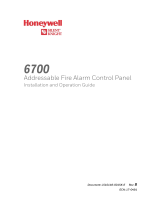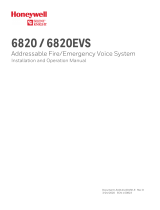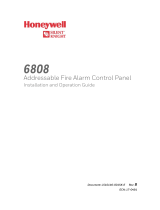Page is loading ...

D550-10-00 1 I56-2600-02R
PF24 Directional Sounder
INSTALLATION AND MAINTENANCE INSTRUCTIONS
3825 Ohio Avenue, St. Charles, Illinois 60174
1-800-SENSOR2, FAX: 630-377-6495
www.systemsensor.com
General Description
Before installing, please read the Directional Sound
Applications Guide, available through System Sensor. The
installation must meet the requirements of the authority
having jurisdiction. Directional sounders are used as sup-
plemental signals on a fire alarm system to aid in the evac-
uation of building occupants. Although directional sound-
ers may be connected to notification appliance circuits
(NAC) for fire alarm service, they are not a replacement for
audible or visible notification appliances as required by the
authority having jurisdiction.
The directional sounder can be installed in systems using
24 Volt DC regulated power supplies only. It is not approved
for use with FWR unregulated power supplies.
Directional sound is a broadband, multi-frequency sound.
The sound source is easily and quickly located by building
occupants, making it ideal for rapid building evacuation.
The Sounder incorporates four different pulse patterns.
The patterns consist of pulses of broadband noise. The four
patterns can be used to create an egress pathway out of a
building. The sound pattern becomes faster as the building
occupant approaches the perimeter exit. Three additional
tone pulses can be added to each of the four pulse patterns.
The first two tone pulses are used to alert occupants that
they are approaching a stairway and need to proceed either
up or down. The second tone pulse is a special tone used
to identify areas of refuge.
Specifications
Mechanical
Input terminals: 12 – 24 AWG
Sounder size: 4 inches (101mm)
Grille Size: 4
7
/8″ (127mm)
Electrical
Voltage Input: Regulated 24 Volts
Operation Voltage Range: 16 to 33 Volts
Operating Humidity Range: 10% to 93% relative humidity non-condensing
Frequency range: 20 Hz to 20 kHz
Operating Temperature range: 32° to 120°F (0° to 49°C)
Power:
1
/4″,
1
/2″, 1, 2 and 4 Watts, selectable
Listings: UL 464 Directional Sounder, supplemental notification appliance
NOTICE: This manual should be left with the owner/user of the equipment.
Power Supply Considerations for
Directional Sounders
Panels typically supply DC filtered voltage or FWR (full-
wave rectified) voltage. This device is only compatible
with DC filtered supplies and must not be used with panel
supplies that are FWR. Be certain the sum of all the device
currents do not exceed the current capability of the panel
power supply. Calculations are based on using the device
current found in Table 1 and must be the current specified
for the installed settings of the device.
Wire Sizes
The last device on the circuit must have sufficient voltage
to operate the device within its rated voltage range. When
calculating the voltage available to the last device, it is nec-
essary to consider the voltage drop due to the resistance of
the wire. The thicker the wire, the less the voltage drop.
Generally, for purposes of determining the wire size neces-
sary for the system, it is best to consider all of the devices
as “lumped” on the end of the supply circuit (simulates
“worst case”).
Typical wire size resistance:
18 AWG solid: Approximately 8 ohms/1,000 ft.
16 AWG solid: Approximately 5 ohms/1,000 ft.
14 AWG solid: Approximately 3 ohms/1,000 ft.
12 AWG solid: Approximately 2 ohms/1,000 ft.
Example: Assume you have 10 devices on a zone and each
requires 50mA average and 2000 ft. of 14 AWG wiring (total
length = outgoing + return). The voltage at the end of the
loop is 0.050 Amps per device
× 10 devices × 3 ohms/1000
ft. × 2000 ft. = 3 volts drop.
I56-2600-02R

D550-10-00 2 I56-2600-02R
The same number of devices using 12 AWG wire will
produce only a 2 volt drop. The same number of devices
using 18 AWG wire will produce an 8 volt drop. Consult
your panel manufacturer’s specifications, as well as the
sounder’s operating voltage to determine the acceptable
voltage drop.
NOTE: If class “A” wiring is installed the wire length may
be up to 4 times the single wire length in this cal-
culation.
Table 1: Current Draw Measurements and
Sound Output Guide
Speed Selection
Power
Setting
Maximum DC
Operating
Current
(mA RMS)
(16 to 33V)
Audibility
(dBA)
(16 to
33V)
Note 1
Audibility
(dBA)
(16 to
33V)
Note 2Speed
Switch
Selection
FAST (exit) 10 4 Watt 225 85 78
FAST (exit) 10 2 Watt 114 82 76
FAST (exit) 10 1 Watt 75 79 73
FAST (exit) 10
1
/2 Watt 62 76 69
FAST (exit) 10
1
/4 Watt 49 73 66
MED1 9 4 Watt 221 85 77
MED1 9 2 Watt 112 82 74
MED1 9 1 Watt 74 79 71
MED1 9
1
/2 Watt 61 76 68
MED1 9
1
/4 Watt 48 73 65
MED2 8 4 Watt 203 85 78
MED2 8 2 Watt 103 82 75
MED2 8 1 Watt 68 79 73
MED2 8
1
/2 Watt 56 76 69
MED2 8
1
/4 Watt 44 73 66
SLOW 7 4 Watt 189 85 76
SLOW 7 2 Watt 96 82 73
SLOW 7 1 Watt 63 79 70
SLOW 7
1
/2 Watt 52 76 67
SLOW 7
1
/4 Watt 41 73 64
NOTE 1: Sound output measured in anechoic room at 10 feet.
NOTE 2: Sound output measured in a reverberant room at 10 feet.
Installation
Consult the Directional Sound Applications Guide for
information regarding the appropriate mounting locations
of directional sounders.
Switch Settings
Selections are made via DIP switches on the back of
the sounder. Switch positions 7-10 are used to select the
pulse pattern of the sounder. Switch 10 is used to mark
the perimeter exit locations (fastest pulse). The remaining
settings are used for egress routing to the perimeter exit.
The egress route would originate with the “slow” (switch
7) tone and follow “medium 2” (switch 8) to “medium 1”
(switch 9) and finally the exit point “fast” (switch 10). If
more than one switch is selected the sounder will default
to the fastest selected setting.
Switch positions 5 and 6 are used to select additional
tone pulses that can be inserted in between bursts of the
directional sound pulses. The additional tone pulse will
be inserted on every 6th directional sound pulse. These
switches should be used when the sounder will be placed
near a stairway to guide a building occupant up or down
the stairs. Switch setting 5 inserts a down sweep indicat
-
ing the presence of a downward stairway. Switch setting 6
inserts an up sweep indicating the presence of an upward
stairway. If switch positions 5 and 6 are both set to “on”
this will insert a special tone for use near areas of refuge.
The area of refuge tone should be used if the directional
sounder is marking an area of refuge. This tone provides
a distinct signal indicating that the sounder is not mark-
ing an exit. If both switches are set to “off” the sounder
will default to no additional tones. In this case only the
directional sound pulses will be heard. See Table 2 for tone
selection options.
Table 2: Additional Tone Selection Guide
Switch
Position 5
Setting
Switch
Position 6
Setting
Sound Output
on on Refuge
on off DOWN Stairs
off on UP Stairs
off off no tones
Switch setting 4 enables a directional sound device to
become disabled when used in conjunction with devices
with dry contacts such as heat sensors or control modules.
The sounder has a set of input terminals that can be con-
figured for an “active open” or “active closed” state. When
the switch is in the “on” position, the sounder is “on”
when the disable connection is closed. When the switch is
in the “off” position, the sounder is “on” when the disable
connection is open. See Table 3 for operation modes.
Table 3: Enable/Disable Function Logic Table
Switch
Position 4
Setting
Terminals 3
& 4
Sound
Output
on open disabled
on closed enabled
off open enabled
off closed disabled
There are five different power settings for the sound output
pressure. Switch settings 1, 2, and 3 set the power setting
for the sounder. Switch 1 selects the 2 watt setting, switch 2
selects the 1 watt setting, switch 3 selects the
1
/2 watt setting.
If all three switches are “off” this selects the 4 watt setting and
if all three switches are “on” this selects the
1
/4 watt setting.

D550-10-00 3 I56-2600-02R
Table 4: Power Setting Guide
Switch
Position 1
Setting
Switch
Position 2
Setting
Switch
Position 3
Setting
Power
Setting
off off off 4 Watt
on off off 2 Watt
off on off 1 Watt
off off on
1
/2 Watt
on on on
1
/4 Watt
NOTE 1: Any other combinations of switch setting for
positions 1, 2, and 3 are invalid and should not
be used.
Consult the Directional Sound Applications Guide for
information regarding the appropriate power, speed, and
additional tone selections.
Electrical
Connect the Sounder as shown in Figure 1 for 2-wire appli-
cations. Connect the sounder as shown in Figure 2 for 4-
wire applications.
4-wire notification appliance circuits are circuits that use a
separate power supply and pair of wires for sounder and
strobe circuits. Some types of notification circuits may provide
coded signals to the sounders by pulsing the power supply on
and off in specific patterns such as the temporal 3 evacuation
signal. The directional sounders should not be connected to
4-wire sounder circuit power supplies where coded signals are
used to pulse the sounders. Directional sounders may be used
in conjunction with sync modules such as the System Sensor
MDL or syncable power supplies. The sounder is compatible
with syncable power supplies using any of the following syn-
cronization protocols; wheelock, gentex, and faraday.
All wiring must be installed in compliance with the
National Electrical Code (NEC) and applicable local codes
as well as special requirements of the authority having
jurisdiction.
Figure 1.
TWO WIRE SYSTEM
ANY MIX OF MODELS
OPTIONAL DISABLE CONTACT
NOTE: SWITCH POSITION 4 SETS
THIS INPUT TO EITHER
ACTIVE OPEN OR ACTIVE CLOSED.
HORN
(+)
(–)
(+)
(–)
E
O
L
(+)
(–)
(+)
(–)
(+)
(–)
HORN/STROBE
DIRECTIONAL
SOUNDER
STROBE ONLY
A0338-00
Figure 2.
FOUR WIRE SYSTEM:
ANY MIX OF HORNS
AND SOUNDERS OR
HORN/STROBES
HORN/STROBE
(+)
(–)
(+)
(–)
E
O
L
(+)
(–)
(+)
(–)
HORN
DIRECTIONAL
SOUNDER
FOUR WIRE SYSTEM:
ANY MIX OF STROBES
AND HORN/STROBES
STROBE
POWER
SUPPLY
SOUNDER
POWER
SUPPLY
(+)
(–)
(+)
(–)
E
O
L
(+)
(–)
STROBE
A0344-00
NOTE: DO NOT loop electrical wiring under terminal
screws. Wires connecting the device to the control
panel must be broken at the device terminal con-
nection in order to maintain electrical supervision.
See Figure 3.
Figure 3.
BREAK WIRE AS SHOWN FOR
SUPERVISION OF CONNECTION.
DO NOT ALLOW STRIPPED WIRE
LEADS TO EXTEND BEYOND SWITCH
HOUSING. DO NOT LOOP WIRES.
A0337-00
The sounder has a set of input terminals to provide addi-
tional control of the sound output of the directional sounder.
These terminals can be connected to the dry relay contacts
of control devices such as heat sensors or control modules.
When the input is active it will disable the sound output
of the Sounder. Connect the disable function as shown in
Figure 4. Refer to Table 3 for function switch settings.
Figure 4.
+ VDC
TO NEXT DEVICE
OR EOL
OPTIONAL DISABLE CONTACT
– VDC
A0339-00

D550-10-00 4 I56-2600-02R
©
2004 System Sensor
The directional sounder will not work without power. The directional sounder
gets its power from the fire/security panel monitoring the alarm system. If power
is cut off for any reason, the directional sounder will not provide the desired audio
warning.
The directional sounder may not be heard. The directional sounder may not be
heard if it is placed on a different floor from the person in hazard or if placed too far
away to be heard over the ambient noise such as traffic, air conditioners, machinery
or music appliances that may prevent alert persons from hearing the sounder. The
Sounder may not be heard by persons who are hearing impaired.
WARNING
The Limitations of Directional Sounders
System Sensor warrants its enclosed directional sounder to be free from defects in
materials and workmanship under normal use and service for a period of three years
from date of manufacture. System Sensor makes no other express warranty for this
directional sounder. No agent, representative, dealer, or employee of the Company
has the authority to increase or alter the obligations or limitations of this Warranty.
The Company’s obligation of this Warranty shall be limited to the repair or replace
-
ment of any part of the directional sounder which is found to be defective in mate
-
rials or workmanship under normal use and service during the three year period
commencing with the date of manufacture. After phoning System Sensor’s toll free
number 800-SENSOR2 (736-7672) for a Return Authorization number, send defective
units postage prepaid to: System Sensor, Returns Department, RA #__________, 3825
FCC Statement
NOTE: Directional Sounder has been tested and found to comply with the limits for a
Class A digital device pursuant to part 15 of the FCC Rules. These limits are designed
to provide reasonable protection against harmful interference when the equipment
is operated in a commercial environment. This equipment generates, uses, and can
radiate radio frequency energy and, if not installed and used in accordance with
the instruction manual, may cause harmful interference to radio communications.
Operation of this equipment in a residential area is likely to cause harmful interfer
-
ence in which case the user will be required to correct the interference at his own
expense.
Three-Year Limited Warranty
Ohio Avenue, St. Charles, IL 60174. Please include a note describing the malfunc-
tion and suspected cause of failure. The Company shall not be obligated to repair or
replace units which are found to be defective because of damage, unreasonable use,
modifications, or alterations occurring after the date of manufacture. In no case shall
the Company be liable for any consequential or incidental damages for breach of this
or any other Warranty, expressed or implied whatsoever, even if the loss or damage
is caused by the Company’s negligence or fault. Some states do not allow the exclu
-
sion or limitation of incidental or consequential damages, so the above limitation or
exclusion may not apply to you. This Warranty gives you specific legal rights, and you
may also have other rights which vary from state to state.
Please refer to insert for the Limitations of Fire Alarm Systems
Mechanical
Two screws are included for attaching the sounder to the
electrical junction box.
NOTE: If surface mounting is required, an extension ring
will be necessary to give proper depth for mount-
ing the sounder. The minimum depth required, in
the backbox/extension ring combination, is 2
1
/4″.
Any combination of 4″ × 4″ backbox and 4″ × 4″
extension ring that gives an interior depth of at
least 2
1
/4″ may be used.
Mounting
See Figure 5. The sounder can be flush mounted on a
4″ × 4″ × 2
1
/4″ back box, as follows:
A. Use the two 8-32 × 1
3
/4″ screws (provided) to attach
the Sounder to the back box.
B. Plug the remaining two holes that will not be used
for attachment with the plugs provided.
Figure 5.
4" x 4" x 2-1/4"
BACKBOX
SPEAKER
SP201 SERIES
8-32
SCREWS
FILL
PLUGS
A0176-04
/





